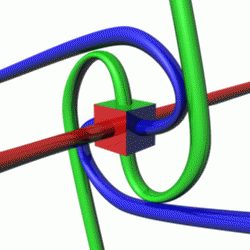Slides for my University of Idaho Colloquium on 6 March 2023 about Entanglement and the 2022 Nobel Prize in physics.
License: MIT
Is Quantum Physics Fundamentally Different than Classical Physics?
Tutorial on the 2022 Nobel Prize
Michael McNeil Forbes
Washington State University and the University of Washington
Experimental Validation
Closing loopholes in tests of Bell's Inequalities
2023 Nobel Prize


Abstract
The 2022 Nobel Prize in physics was awarded to Alain Aspect, John F. Clauser, and Anton Zeilinger
“for experiments with entangled photons, establishing the violation of Bell inequalities and pioneering quantum information science”.
The inequalities set forth by John Bell provide a formal proof supporting the view of Bohr and Schrödinger, that quantum mechanics is fundamentally incompatible with the local realist model of classical physics favored by Einstein, Podolsky, and Rosen (EPR). The 2022 Nobel Prize recognizes the experimental efforts made to test the violations of these inequalities, supporting the predictions of the quantum theory.
In this colloquium I will provide a pedagogical but rigorous explanation of a modern formulation of quantum theory, demonstrating a form of the Bell inequalities due to John Clauser, Michael Horne, Abner Shimony, and Richard Holt (CHSH), whose violation supports the reality of quantum entanglement – what Schrödinger called “the characteristic trait of quantum mechanics, the one that enforces its entire departure from classical lines of thought”.
I will discuss aspects of the experiments, what the results mean for our interpretation of reality, and try to shed some light on the question posed in my title.
This cell contains math definitions.
Outline
What is Quantum Mechanics?
Qubits: Spin 1/2,
Two particles:
The Einstein-Podolski-Rosen (EPR) "paradox". Spooky action at a distance.
The Bell inequalities (CHSH formulation)
Experimental tests: the 2022 Nobel Prize
Discussion: Teleportation, Delayed-Choice Quantum Eraser (no retrocausality) Superdeterminism
Questions?
EPR

What is Classical Mechanics?
Kinematics: How do we describe the behaviour of a particle?
Dynamics: How do we see if the behaviour is physical?
Alternative formulations: Lagrangian and Hamiltonian. I.e.
What is Quantum Mechanics?
Kinematics: How do we describe the behaviour of a particle?
Dynamics: How do we see if the behaviour is physical?
What is Quantum Mechanics?
Linear Algebra (Heisenberg's Matrix Mechanics)
Wavefunction is a vector (in Hilbert space).
"Observables" become operators:
What is Quantum Mechanics?
Eigenvectors and Eigenvalues
Measurement
aka "Nobody understands quantum mechanics"
Many Particles?
Classical: variables , , , ...
times as much information.
Quantum: Wavefunction of variables
Tensor product.
Exponential amount of information: .
Hilbert space is big!
Note: 1 particle in 2D is mathematically equivalent to 2 particles in 1D.
Postulates of Quantum Mechanics
The state of an isolated systems is a complex unit vector . (Hilbert space.) . (phase equivalence)
States evolve under unitary operations: where .
Measurements are a set of operators such that . A measurement made on the state will produce outcome with probability , transforming the state as follows:
Composite systems have states in the tensor product of the component Hilbert spaces.
Nielson and Chuang
Qubits (Spin 1/2)

Intererence

Particle Intererence


Measure state where angle between detector and state is :


Qubits (Bloch Sphere)
Expectation Value
Qubits (Spin 1/2)

Two Qubits (Tensor Product)
Entanglement
Start with . Alice does stuff and Bob does stuff . They generate no entanglement: State remains a product:
Bell States cannot be written as products:
Entanglement: Singlet
Einstein-Podolsky-Rosen (EPR)

Hidden Variable λ
Local Realism: .
Quantum:
Bell Inequalities
Bell proved:
Take , , and :
Quantum:
Quantum Calculation
WLoG: Alice measures , Bob measures .
Thus
Bell proved:
Take , , and , and use quantum :
Bell Inequalities
Clauser-Horne-Shimony-Holt (CHSH)
Consider four measurements with values – two for Alice , and two for Bob , :
Quantum gives:
2023 Nobel Prize
Experimental Validation
Closing loopholes




Coincidence Detection

Discussion
Local Realism:
Counterfactuals:
Superdeterminism
Teleportation

